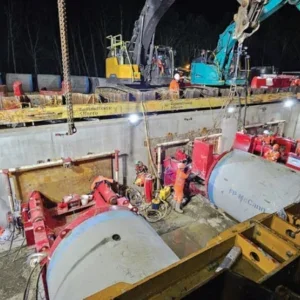These twin-track tunnels have been designed with a double-shell lining, with waterproofing and drainage between the shells. The tunnels, with overburdens ranging from 10m-60m, are to be excavated in a hilly area of molasse, predominantly in compacted tertiary fills, the Oncophora sands, an interstratification of poorly consolidated clay and sandstone.
The design, which has been carried out by a JV of ILF Consulting Engineers, smh and IMM, covers both NATM and TBM tunnelling methods. The decision as to which method will ultimately be implemented depends on the tendering results. For the TBM excavation, a single-shield machine without active face support and with an excavation diameter of 12.98m is intended.
The segmental rings consist of five rectangular elements plus a keystone in the invert. Joints in the segmental rings permit groundwater seepage, preventing the build-up of groundwater pressure acting on the segmental lining.
The segmental lining would be constructed by first installing two segments in the invert, followed by the sidewall segments.
While these are held in place by supporting rollers, the segment in the crown is brought into position and fixed by spreading the segments in the invert and placing a keystone.
In the lower sidewall section, the segments are provided with a shoulder, which will serve as a basis for the 300mm thick, cast in-situ secondary lining.
The contract is due to be awarded in autumn 2004, with construction scheduled to get underway in February 2005. The works are due to be completed in 2009.
Tel: +43 512 24 12 113
Email: thomas.fritz@ibk.ilf.com






